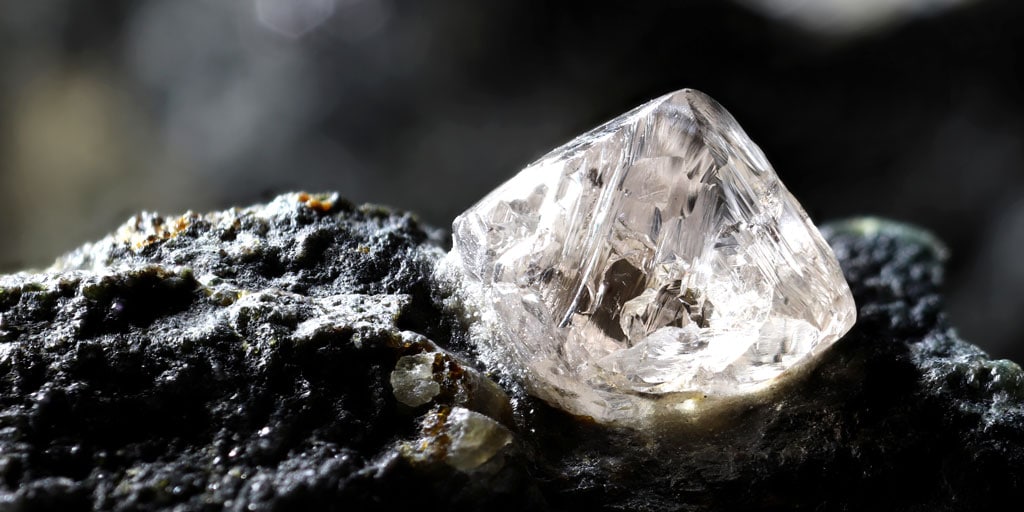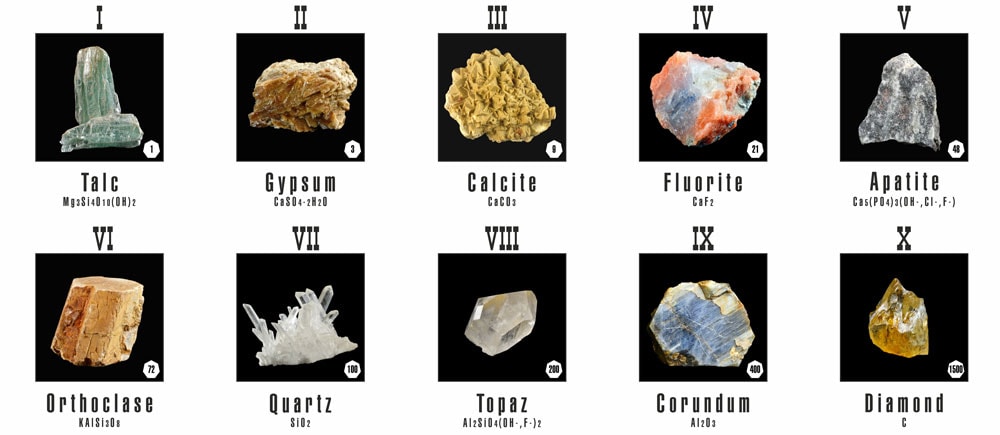
Have you ever wondered how the Mohs crystal hardness scale works? In this article I’ll explain the scale and why it’s important for crystal healing.
Hardness is a measure of how resistant a crystal is to being scratched. The Mohs hardness scale is one method for classifying hardness, with stones rated from one (softest) to ten (hardest).
In this article I’ll discuss the Mohs hardness scale and how it works. I’ll also explain whether it’s useful for deciding how to store or cleanse your crystal collection.
What is the Mohs Scale of Crystal Hardness?
The Mohs hardness scale rates the hardness of a crystal or gemstone on a scale of one to ten. While the Mohs scale can be useful for understanding a crystal’s properties, it’s not the only consideration when judging a stone’s water safety or storage requirements.
What is the Mohs Scale of Hardness?
In short, the Mohs hardness scale measures the hardness of a crystal.
It’s an approximate guide that ranks a mineral by how easily it can be scratched by another. The grade goes from one to ten, with ten being the hardest.
| Hardness | Mineral |
| 1 | Talc |
| 2 | Gypsum |
| 3 | Calcite |
| 4 | Fluorite |
| 5 | Apatite |
| 6 | Feldspar |
| 7 | Quartz |
| 8 | Topaz |
| 9 | Corundum |
| 10 | Diamond |
There are ten minerals used as a guide to the Mohs scale. Each test mineral can scratch those that are lower on the scale. For example, you can see in the table above that fluorite could scratch calcite, gypsum, and talc, but not apatite or quartz.
Why is the Mohs Scale Important for Crystal Healing?
As crystal healers, we cherish our crystal collection and want to protect our stones. The Mohs scale of mineral hardness gives us a quick guide to how delicately we need to handle different crystals.
Here are a few examples of how we can use the Mohs scale:
- Soft stones need to be dusted with a softer makeup brush to avoid scratching.
- Hard stones shouldn’t be stored in the same pocket or bag as softer ones.
- Stones that are low on the Mohs scale may need extra protection when travelling.
- Crystals below six on the scale usually shouldn’t be cleansed in water (although there are exceptions – more on that later in the article.)
Who Created the Mohs Hardness Scale?
This Mohs hardness scale was created by a Professor of Mineralogy in Graz, Austria, called Friedrich Mohs in 1812. Since then, it has become the accepted standard.
What Determines a Crystal’s Hardness?

The atoms and molecules of a gemstone form a crystal lattice. This lattice is held together by bonds, and it’s the strength of these bonds which are responsible for the hardness of a crystal.
This doesn’t mean that all crystals of the same type have exactly the same hardness though. Inclusions can weaken a crystal and make it more susceptible to damage. Existing cracks in a stone can also cause structural weakness.
Even the direction of the Mohs hardness test can affect the result. For example, Kyanite, which has a bladed structure, tests approximately 4.5 when scratched along the length, and 6.5 or 7 if tested across the width.
Crystal Hardness Scale Reference Chart for Selected Gemstone
- 1 – Talc, Pyrophyllite
- 2 – Gypsum, Fuchsite
- 3 – Calcite, Wulfenite, Shortite, Bornite
- 4 – Flourite, Leucophanite, Ammonite, Rhodochrosite
- 5 – Apatite, Dioptase, Rinkite
- 6 – Aegirine, Humite, Lawsonite
- 7 – Quartz, Smoky Quartz, Aventurine, Amethyst
- 8 – Topaz, Spinel
- 9 – Ruby, Sapphire
- 10 – Diamond
What Hardness is Required for a Crystal to be Safe to Cleanse in Water?
The general rule is that if a crystal ranks six or above on the Mohs hardness scale, it’s safe to be cleansed in water – at least for short periods. But hardness isn’t the only consideration, as the Mohs scale is not a test for water suitability.
Some crystals contain extra minerals that can be affected by water. Hematite, for example, rates between 5.5-6.5 on the Mohs hardness scale, but the iron content will rust when it gets wet. Rhodonite also has a rating of 5.5-6.5 with iron content, so it’s only safe in water for short periods.
Tangerine quartz also contains iron oxide, which is the reason for its lovely colour. This may fade in water, even though the stone itself rates as a seven on the Mohs scale. Jet, which ranges between 2.5 and 4, can actually tolerate water.
There are also crystals which may leak toxic substances when placed in water. Be careful to avoid these stones when making crystal elixirs.
So, you can see from these examples that the hardness of a crystal isn’t the only consideration when deciding if a stone can get wet. It’s still a useful guide for many crystals though.
Note: Even if a crystal’s appearance is affected by water, it doesn’t harm the crystals resonance and healing properties.
Does a Crystal’s Hardness Affect Its Healing Properties?
Hardness doesn’t directly affect a crystal’s healing properties, but it can affect which stone to choose in different situations.
When wearing gemstones in jewellery, it’s important to choose a stone that’s unlikely to get damaged. A gemstone in a ring is more likely to get scratched than one in an earring, for example, so you may want to choose a harder stone.
The same is true when travelling. When packing crystals for a trip, choose ones that both resonate with your desired intentions and have a durable structure.
Be Careful When Dusting!
Quartz is found in dust. As quartz is a seven on the Mohs scale, be careful when dusting softer crystals to avoid scratching them.
Frequently Asked Questions
Which is the Hardest Mineral on the Mohs Hardness Scale?
The hardest mineral on the Mohs hardness scale is diamond. It sits at 10 on the scale, which shows that diamond cannot be scratched by any of the minerals below it.
Are the Increments on the Mohs Scale Equal in Hardness?
No, the scale represents relative hardness rather than absolute. While the intervals are roughly the same at the lower ratings, the gaps get larger towards the harder end of the scale.
For example, the increase in hardness from calcite to fluorite is approximately 25%. The increase from corundum to diamond is around 300%.
Are There Alternative Hardness Scales?
There are many other hardness scales, including those created by Vickers (1920) and Knoop (1939). Unlike the Mohs scale, these measure the resistance to indentation under pressure. The permanent depth of the indentation is measured which is converted to a hardness value.
In the future it’s likely that a new hardness scale will be invented. This is due to minerals harder than diamonds being discovered.
Summary
The Mohs scale measures the hardness of a crystal. Each stone is rated out of ten, with crystals of higher ratings able to scratch those at lower ratings.
While the Mohs scale is a useful tool for making jewellery or deciding how to store a gemstone, it’s not a test for water suitability.
Do you have any questions about the Mohs scale of crystal hardness? Please let me know in the comments section below.
